
The Nairana-class escort carrier were three converted fast diesel cargo ships built in England, Ireland and Scotland, on a stnadard basic design launched in mid-1943 and requisitioned by the RN to be converted. They however could only accommodate a composite squadron of 15–20 aircraft over a 16,000 tonnes displacement. HMS Campania was the first British carrier fitted with an Action Information Organisation (AIO), ancestor of modern central operation rooms, plus the state of the art Type 277 radar. All three served as convoy escorts at the time (1944-1945) when the battle of the Atlantic was nearly over. They still had U-Boat and Luftwaffe kills in their patrols but their service was relatively less eventful than prior carriers in 1942-43. They were sold back to merchant service in 1947-48, Nairana being lent as the Dutch escort carrier Kartel Doorman in 1946-48. #ww2 #royalnavy #escortcarrier #nairana #vindex #campania
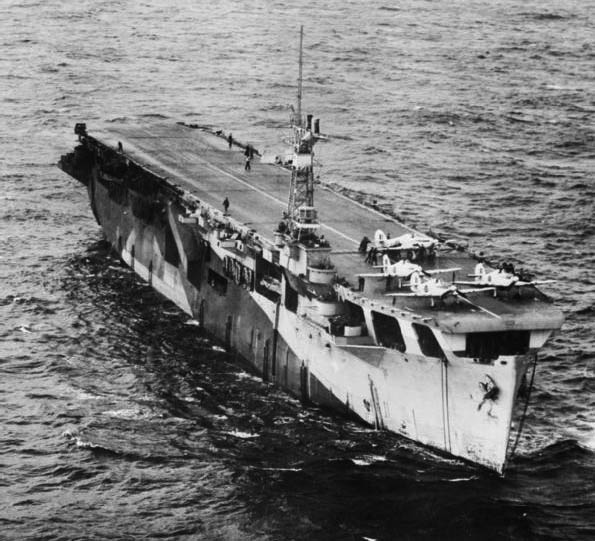
Development
In late 1942, the rampage of U-Boat in the Atlantic was at its peak. The need for escorts of all types was ramping up, notably corvettes and soon frigates, whereas the US started its massive program of destroyer escorts. Since 1941, the conversion of cargo ships into escort carriers was acted, validated, and both in Britain and the US, more conversions started. In mid-late 1942, large cargo ships powered by diesels but capable of 16 knots were in construction at John Brown, Swan Hunter and Harland & Wolff, belong to the same class, were considered by the admiralty for conversion. It was decided before their launch in May 1943 for the first two (renamed Vindex and Nairana) and June for the third (Campania) to requisition them for conversion as escort carriers on a design derived from previous conversions, notably on Audacity and Activity.
It should be noted that British yards being at full capacity, few of such conversions were made during world war two. Apart the ones cited and the much larger HMS Pretoria Castle, the immense majority of British escort carriers came from the US, via lend lease: HMS Archer, the three Avengers, and the numerous Attacker and Ameer classes based on standard Maritime Commission Cargoes, generally C3 types. The only exception would be very austere conversions of the “Empire” Merchant Aircraft Carriers (MAC) which consisted in placing a flight deck over a standard cargo vessel, without hangar, lift or catapult and a permanent park of three Swordfish. The latter in addition were operated by the national wartime merchant marine organization, with civilian crews mixed with RN crews. And they still operated as regular cargos, carrying useful loads across the Atlantic.
Arguably, the Nairana class were the last, and for many authors, best British escort aircraft carriers. They carried a maximum of 18 aircraft versus up to 24 on the Ameer/Attackers, whereas displacing much, over 17,000 tonnes versus 14-15,000 for the C3 based lend-lease vessels. Part of the reasons laid in their quick conversions on hulls perhaps not best suited for this, limited size hangar, small island and cramped accomodations. However they had good advantages compared to previous designs: Their small, compact engines allowed quick operation (no heating time), and allowed to increase the number of watertight bulkheads to survive a torpedo hit. They also had a more rational arrangement for aviation magazines and petrol tanks, which were buried deeper and safer overall. Nairana and Campania also had a strengthened flight deck plus additional hull strength. Their hangar was also unusually wide and for extra stability foir flight operations, they carried a 3,000t lead ballast which replaced their useful payload. This freed space while giving them a lower metacentric height.
As diesel ships, they were 1.5 knots slower than steam powered lend-lease C3 vessels, and carried less oil, although the consumption of the Diesels compensated for this and their range was greater at 13,000 nm at 16 knots. It should be noted that they diverged considerably between them and in most publication, the first two are assimilated in the “Vindex class” and HMS Campania is often seen as its own class, albeit very similar.
It’s John Brown of Clydebank which built the prototype, based upon the HMS Activity conversion plans and modified, and these plan’s copies were supplied to the other Yards, Harland & Wollff in northern Ireland and Swan Hunter at Wallsend, Tyne and Wear. They were all slightly different in the end and diverged in specifications.
Design of the class
Hull and general design
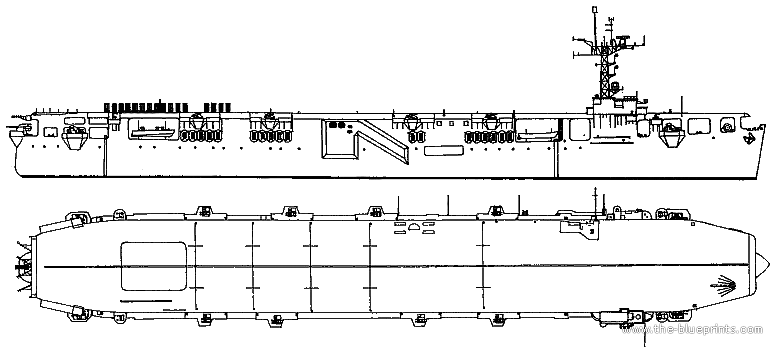
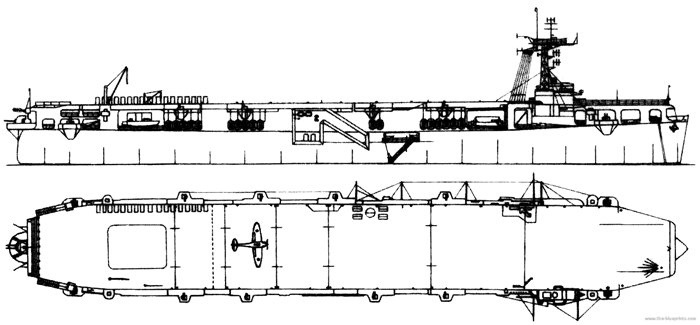
Nairana (top) and Vindex (bottom)
Nairana (John Brown) was the first laid down, Nov. 6, 1941, but not the first launched (on 20 May 1943) and she was completed on 12 December 1943, a week after Vindex, so the latter is often used in publications as the lead ship for the class instead. Her hull, like the two others, was of riveted construction. Apart fine entries and a near straight prow, the hull was rectangular, dying aft into a curved stern. Single rudder but two shafts. She displaced 14,050 or 13,825 long tons (14,280 t) standard depending on sources, 17,210 tons fully loaded (she was the heaviest of the three). She measured 528 ft 6 in (161.09 m) overall, 68 ft 6 in (20.88 m) in beam and for a 21 ft (6.4 m) draught, crew 728 men. As for facilities, she had a 495 ft (151 m) flight deck (3,124m²), her hangar measured 231 ft (70 m) in lenght and 61 ft (19 m) in width (1,309m² or 6,979m³). Her deck was outfitted with eight arrestor wires and she had a single aircraft lift aft measuring 45 ft (14 m) by 34 ft (10 m). No catapult as the idea was aircraft would be parked at the aft section, and in normal operations, patrol planes would be lifted out of the hangar and then took off using 2/3 of the deck to take off.

From pinterest
Vindex (Swan Hunter) was not first laid down (1st July 1940), but she was the first launched, on 4 May 1943, and first completed on 3 December 1943. He crew was noted as 700 officers and ratings. She displaced less, 13,455 long tons (13,671 t) standard, 16,830 long tons fully loaded. She was bit shorter at 524 ft (160 m), for 68 ft 6 in (20.88 m) in beam, and 21 ft (6.4 m) draught. Aircraft facilities comprised the exact same flight deck, hangar, arrestor wires and lift however.
HMS Campania (Harland and Wolff) was however the last laid down and launched, on 17 June 1943, and last completed on 9 February 1944. Crew was also 700 men and she appeared the lightest of the three at 12,450 long tons (12,650 t) in displacement standard, 15,970 tons fully loaded. The reason she was considered her own class where her differing dimensions, not in overal lenght at 540 ft (160 m), neither but for her beam of 70 ft (21 m) but lower draught of 19 ft (5.8 m). Her flight deck was the same, but her hangar was much shorter at 198 ft (60 m) for a slighty better width of 61 ft 6 in (18.75 m), so 1,172m² in superficy and 6,245m³ in volume. However she had the same six arrestor wires, aircraft lift, placed the exact same way. So in short, her hangar was almost only 1/2 sized compared to her overall lenght, not optimal for aircraft capacity (see later). Other sources had the lift different, at 13.7 x 10.4m and capable of lifting 4.6t.
It seems also Campania was the only one given a steam catapult, a C-II model capable of projecting a 6.4t plane at 122 km/h (some sources says Vindex and Nairana received one also). Aircraft fuel stowage was 236,000 liters for all three.
Powerplant

HMS Vindex underway – src destinationjourney
All three however had the same diesel powerplant: Two 2 Doxford (Nairana-Vindex) Burmeister & Wain (Campania) diesel engines driving two shafts for a total of 10,700 or 11,000 brake horsepower (bhp) that would provide them 17 knots (31 km/h; 20 mph) of top speed, albeit specs differed again. All three carried a bunkerage of diesel oil of 2,230 tonnes for an endurance of 17,000 nm at 16 knots.
Armament
Main: Twin 4-in/45 QF Mk XVI
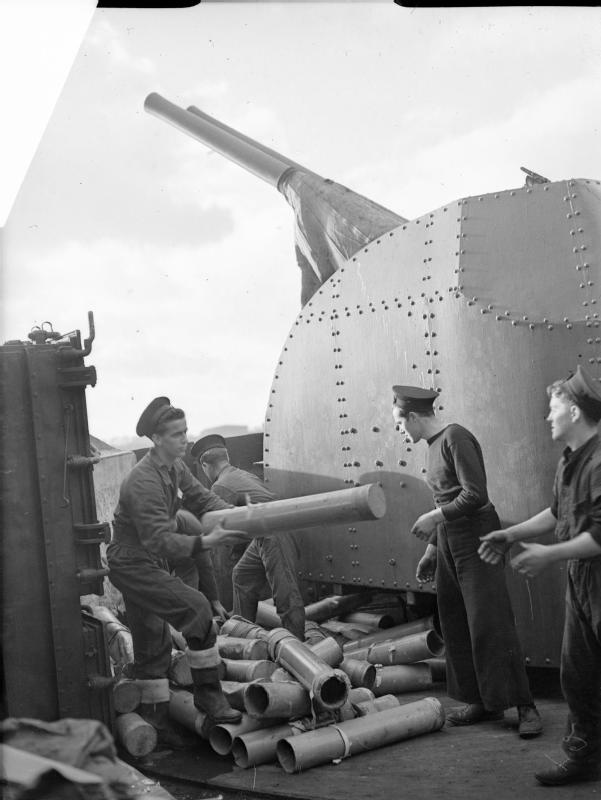
The main arement was a single dual purpose turret, with a twin mount 104 mm or 4-in/45 QF Mark XVI guns, widespread in the RN. It was located on an axial stern sponson. Barrel & breech weighted 4,495 lb (2,039 kg) and it fixed a fixed QF 35 pounds (15.88 kg) HE or 38.25 pounds (17.35 kg) S.A.P. at 15–20 rpm (2,660 feet per second/811 m/s) at 19,850 yards (18,150 m)/45° of 39,000 feet (11,890 m) at 80° against aircraft.
AA
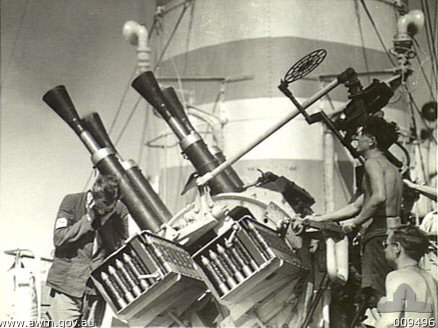
This was completed by four quadruple “pom pom” 40mm of 2-pdr/39 2pdr QF Mk VIII. They were placed on each corner, two sponsoned at the stern, samel level as the turret, and two at the weather deck level forward, close to the prow, for extra arc of fire. Although less performing than Bofors L/60, they fired a 2 lb. (980 g) or 1.8 lb. (820 g) for the High-Velocity (HV) round at 115 rpm in fully automatic, but were limited in range at 3,800 yards (3,475 m) or 5,000 yards (4,572 m) with a Ceiling (HV) of 13,300 feet (3,960 m). Muzzle Velocity varied from 2,040 ft/s (622 m/s) to 2400 ft/s (732 m/s) for the High Velocity round.
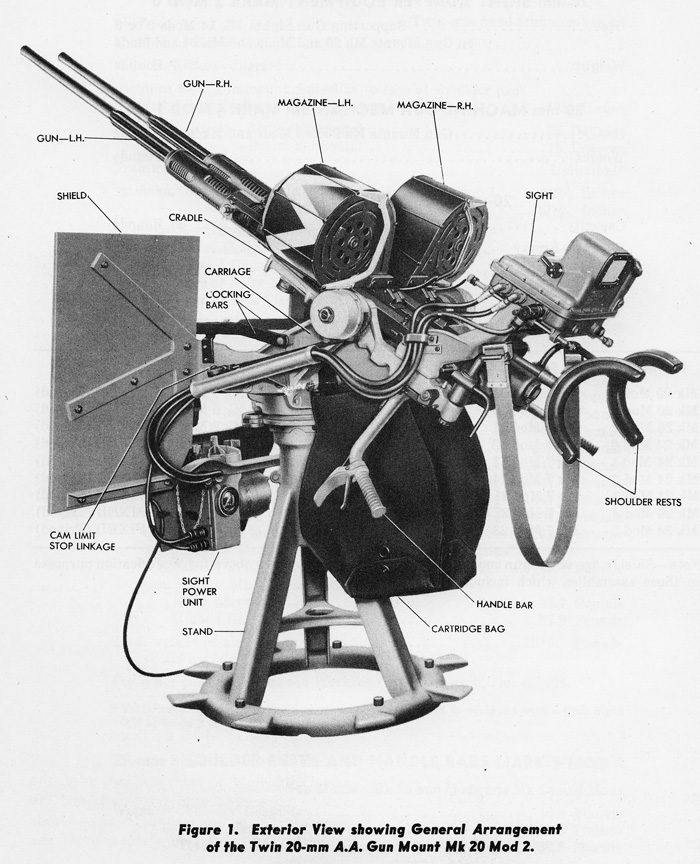
And there were eight twin 20mm/70 Oerlikon Mk II/IV located on sponsons along the flight deck wherever possible, each ship having four positions either beam. Specs are well known, detailed here.
These dependable mounts procured a last ditch close AA defense, but were limited both in range and hitting power, albeit, they required less personal.
All in all, between her twin dual purpose turret and twenty four AA guns they were well armed, especially considering that HMS Activity only had 20 mm guns, no “pom-pom”, ideal to bring maximal density of firepower in close defense.
Sensors
Each ship carried a set of radars placed on the single derrrick mast on top pf the short island. The latter only comprised a single level above the flight deck, and was narrow with an open bridge. A projector was installed on a platform forward.
Nairana and Vindex had the type 277, type 281В, and four type 282 radars for the pompom, plus a type 293 radar.
Campania had the type 276, same type 277, and the type 281B radar instead of the 293.
Type 276: Refinement on the Type 271 naval sea search radar, “single cheese” antenna. A-scope display, later PPI display. Wvl 10 cm, Pwd 1.5/1.9 ms PRF 500 Hz 2-18 rpm, 500 kW
Type 277: Sea-surface search, early warning FRQ 2950 ±50 MHz (S-band) PRF 500 Hz Bamwdth 6.2º Pwd 1.8 or 0.7 µs, 16 rpm range 1-11 bm (1.9–20.4 km) prec 250 yards, 500 kW
Type 281B: Better transmission/receiving antenna Early-warning radar FRQ 86–94 MHz PRF 50/s Bwd 35°, Pwt 2–3 μs/15 μs Range 115 nmi (213 km; 132 mi) alt 30,000 feet (9,100 m), 350W.
Type 293: Aerial-search radar FRQ 2,997 MHz Bwt 3.2° Range 20 nmi (37 km; 23 mi), alt. 20,000 ft (6,100 m) 500 kW
Upgrades
None was done durng wartime for the first two, after the end of the war they were noted having the 4-in/45 QMk XIX guns, and same radars.
Campania however received two extra quadruple 40mm/39 2pdr QF Mk VIII pompom (she was completed with four like her sisters), her main guns were upgraded to Mark XIX, but still still had her four 40/39 Mk VII pompom mounts and eight twin 20mm/70 Mk V Oerlikon and radars.
In 1951 however all her pompom were removed and Oerlikon guns, and instead she obtained two twin shielded 40mm/60 Mk 5 Bofors and two single 40mm/60 Mk 7 Bofors as well as two type fire control 262 radars.
Air Group
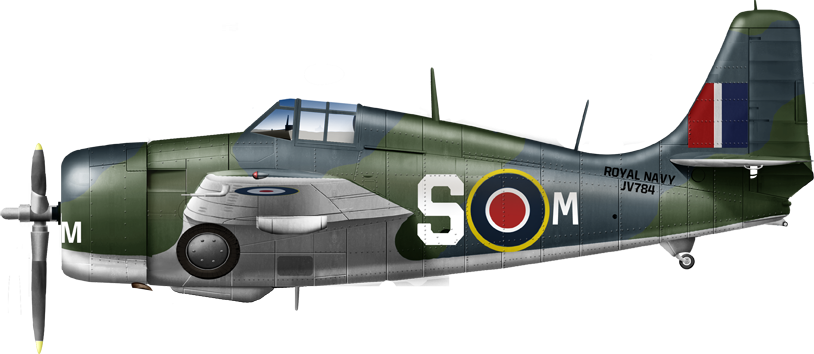
Wildcat Mark VI SM784, 825 Squadron, HMS Campania 1945
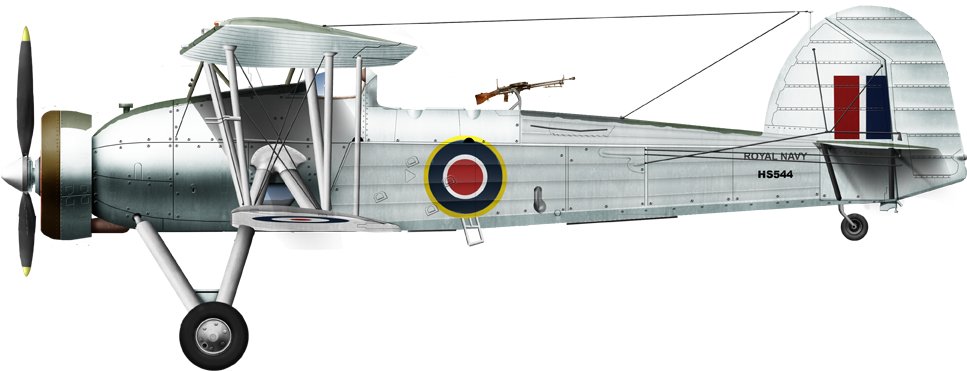
Fairey Swordfish Mark 2 FAA 835 NS HS544, HMS Nairana 1944
18 aircraft which park greatly diverged. At first they were setup to carry Fairey Fulmar, Sea Hurricane, Supermarine Seafire, and Martlet fighters, as well as Swordfish as main torpedo bombers an patrol, ASW planes, which will do the heavy lifting. The composite sqn. diverged over time also:
For example in January 1944, Nairana operated three Sea Hurricane for self defense and nine Swordfish to do the heavy lifting, which was far less than the max capacity.
This was reached with Vindex in March, with a true squadron of six Sea Hurricane and two squadrons of 6(12) Swordfish. Only change later that year was the swap to four Wildcats, which became standard until the end of the war. Late 1944 Nairana operated at full capacity with six Wildcats and Twelve Swordfish, so 18 aircraft. Vindex in 1945 reversed the trend with two Wildcat squadrons (12) and one of Swordfish (8);
HMS Campania followed that trend, albeit she was completed later, but she combined 4 Wildcat for interception, 3 multirole/long range Fulmar fighters, and 12 Swordfish in june 1944.
Later she had more or less the same composition of 4-8 Wildcat 8-12 Swordfish depending on the mission, generally more of the latter. She also carried a single Fulmar in early 1945, which was an RAF A1 air-to-air interception radar night fighter, inaugurated already on her sister Nairana in the Arctic.
Wear and tear as well as pilot losses were horrendous as the ships operated in Northern and Arctic waters. Often they had more planes than crews in order to replace the 30-40% losses solely due to accidents, mostly when landing. Unfortunately many crews were also lost.
⚙ specifications |
|
| Displacement | 12,450/14,050/13,455 long tons standard |
| Dimensions | 540/528/524 ft (160-161.09 m) x 70/68 ft 6 in ft (21-20.88 m) x 19-21 ft (5.8/6.4 m) |
| Propulsion | 2 shaft diesel engines, 11,000 bhp (8,200 kW) |
| Speed | 17 knots (31 km/h; 20 mph) |
| Range | Diesel oil 2,230t, 17,000 nm at 16 kts |
| Armament | 2x 4 in DP, 16x (4×4) 2 Pdr Pom Pom, 16x (8×2) 20 mm oerlikon |
| Sensors | type 276, type 277, type 281B radars, see notes |
| Air Group | 18-20 aircraft |
| Crew | 700-728 |
Read More/Src
Books
Conways all the world’s fighting ships 1921-47, page 24.
Brown, David (1973). Fairey Fulmar Mks I & II, Aircraft. London: Hylton Lacy Publishers.
Cocker, Maurice (2008). Aircraft-Carrying Ships of the Royal Navy. The History Press.
Friedman, Norman (1988). British Carrier Aviation: the Evolution of the Ships and their Aircraft. Conway Maritime Press
Morison, Samuel (2002). History of United States Naval Operations in World War II. University of Illinois Press.
Poolman, Kenneth (1972). Escort Carrier 1941–1945. London: Ian Allan.
Speller, Ian (2004). The Royal Navy and Maritime Power in the Twentieth Century. New York: Routledge.
Thomas, Andrew (2007). Royal Navy Aces of World War 2. Oxford: Osprey Publishing.
Brian Cathcart (1994). Test of Greatness, Britain’s struggle for the atom bomb. John Murray.
Becky Conekin (2003). The Autobiography of a Nation: The 1951 Festival of Britain. Manchester University Press.
Cocker, Maurice (2008). Aircraft-Carrying Ships of the Royal Navy. Stroud, Gloucestershire: The History Press.
Gittins, Jean (1982). Stanley: Behind Barbed Wire. Hong Kong: Hong Kong University Press.
Poolman, Kenneth (1972). Escort Carrier 1941–1945. London: Ian Allan.
Links
navypedia.org/
en.wikipedia.org
uboat.net/
red-duster.co.uk/
http://www.photoship.co.uk/
uboat.net/
royalnavyresearcharchive.org.uk
news.bbc.co.uk/
red-duster.co.uk/PORT7.htm
hazegray.org/
armahobbynews.pl wildcat vi FAA
Videos
Model Kits
https://www.scalemates.com/search.php?fkSECTION%5B%5D=All&q=hms+nairana*
https://www.scalemates.com/search.php?fkSECTION%5B%5D=All&q=hms+campania*
https://www.scalemates.com/search.php?fkSECTION%5B%5D=All&q=hms+vindex*
https://www.klueser.de/kit.php?index=6441&language=en
3D
https://www.deviantart.com/digitalexplorations/art/BRN-Nairana-class-escort-carrier-CFS2-891904206
 HMS Vindex
HMS Vindex
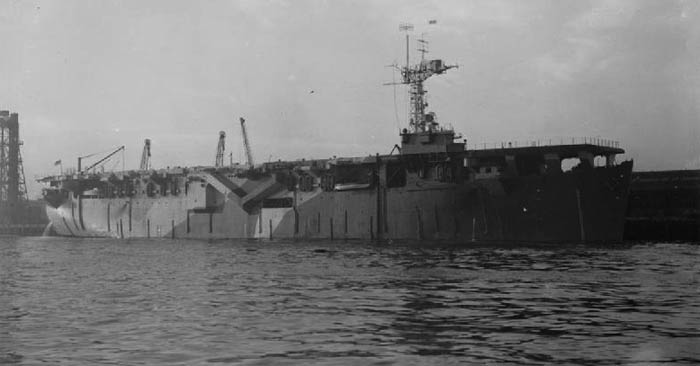
Vindex as completed
HMMS Vindex was commissioned in December 1943 and started working up in Gourock in a context where she coud operate wioth a second or third carrier per convoy, and be detached in a “hunter killer group” outside the convoy system, so she was trained for this. She was assigned for her first mission to the 2nd Escort Group (Captain Frederic John Walker) and she was to operate alone, given the experienced 825 Naval Air Squadro (12 Fairey Swordfish Mk IIs, six Sea Hurricanes IICs. The wear and tear was such however she only had eight crews and Sea Hurricanes performed the daylight anti-submarine patrols, fitted with four RP-3 rockets like the Swordfish. They were turned as sub-hunters, another role added to the underappreciated Hurricanes.
She left Northern Ireland on 9 March 1944 and moved to a site designated to likely be the highest concentration of U-boats in the area. On the night of 12 March, a Swordfish with radar got 28 contacts and attacked but her two depth charges failed to explode probably because of faulty safety clips while a rear gunner was killed by FLAK. Three attacked that same night failed but on 15 March, also by night, two Swordfish also got contact, dropped flares to mark the location and the escort group arrived, got an ASDIC contact and indeed sunk U-653. Weather conditions prevented further flying. One Swordfish was later reported missing. On Swordfish crash into the sea on take-off, another due to engine failure, in rousing seas. One also clipped the island superstructure but the pilot managed to take off, jettisoned his depth charges and landed back. Her planes also sometimes missed the arrestor wires and ended in the safety barriers.
On 24 March, another Swordfish crash-landed and leaking petrol detonated two depth charges which holed the deck over 8 ft × 4 ft (2.4 m × 1.2 m) so she had to return to port for repairs.
Late April 1944, saw her assigned to the 5th Escort Group. On 6 May a Swordfish was contacted by two River class frigates reporting contect with a submerged U-boat until they forced U-765 to the surface, hit by two Swordfish depth charges, sinking her. Later poor visibility again marred air operations, one Sea Hurricane was badlydamaged when crashing, another lost at sea. Three Swordfish were also lost. On 9 May her sole aircraft lift broke down and the crew manually cranked it up and down, each needed one hour. Repaired Vindex made a second deployment (400 sorties, 13 days) but ended with 35% of her original crews. Lt. J.M. Morrison invented a blind landing system with a modified ASV radar set for the Air Directing Officer which would help future landings.
On 15 August, Vindex and HMS Striker escorted convoy JW 59 in the Arctic. She had the 825 Naval Air Squadron with new ASV radar equipped Swordfish Mk III using RATOG and carried 12 of them plus eight Sea Hurricanes including two in spares. On 22 August they claimed U-344, and U-354 on 24 August plus one damaged. Both JW 59/RA 59A were safe, no loss.
They escorted laoer convoy JW 61 on 20 October with Vindex, Nairana and Tracker, 62 merchant ships under Vice-Admiral Frederick Dalrymple-Hamilton, Vindex being used as flagship. She also carried the 811 Naval Air Squadron. Most flying was done by night, the three carriers alternating hour watches. HMS Tracker’s Avengers worked daylight patrols. No U-boats or reconnaissance aircraft spotted and the convoy arrived safely in Kola Inlet. Return convoy RA 61 was equally safe apart a frigate damaged by a torpedo after leaving Kola (ambushing U-Boat). Vindex however lost a Wildcat and later a Swordfish and had in total eight Swordfish and two Wildcats damaged beyond repairs.
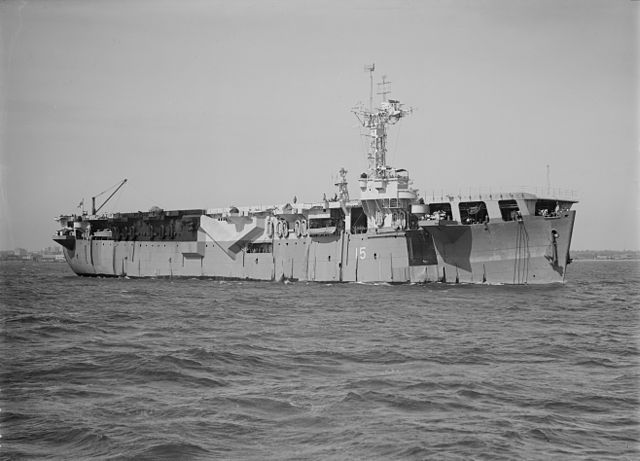
Vindex in 1945
From March to August 1945 she was detached to the British Pacific Fleet (BPF) and joined the 30th Aircraft Carrier Squadron. Nothing of note happened and she stayed in Far East as flagship for Rear Admiral Angus Cunninghame Graham. She took part in Magic Carpet, repatriating POWs from Hong Kong to Australia and Britain. and was placed in reserve on arrival. The RN then ceded here back to the Port Line company which ordered her in the first place so she was renamed her Port Vindex, and converted into a refrigerated cargo ship to sail to Australia and back with frozen meat. She was scrapped in August 1971 in Kaohsiung (Taiwan).
 HMS Nairana
HMS Nairana

HMS Nairana was commissioned in December 1943 and had trials and qualif. at Gourock with the 835 Naval Air Squadron (835 NAS: 9 Swordfish, 6 Sea Hurricanes), which were previously experienced, on HMS Activity. Both her and Nairana left the Clyde on 29 January with the 2nd Escort Group (Captain Frederic John Walker) to create a 2-carrier hunter killer group west of Ireland, distant support for convoys OS 66 and KMS 70 in pooe Weather conditions. Nairana started later her first ASW patrol and assisted later HMS Wild Goose sinking U-592. Late May 1944, saw her with the 15th Escort Group for day and night sorties and some contacts but the U-Boat could detect these early ASV Swordfish radars and flee the area. She escorted the convoys SL 157/MKS 48, SL 158/MKS 49 but on 25 May, a German Junkers Ju 290 flew over in recce, repelled by Sea Hurricane but Vindex lost her fist pilot. On 26 May 1944 Sea Hurricane (Sub-Lieutenant Burgham) shot down Ju 290 9K+FK of FAGr 5 over the Bay of Biscay. Mearns and Wallis shooted down 9V+GK while the other was badly damaged and presumed crashed.
Next she escorted the Arctic convoy JW 61 from 20 October with Vindex and Tracker. She then carried 14 Swordfish IIIs and six Wildcat VIs and performed eight-hour watches, mostly working night patrols. And being in standby by day and preparing for the next shift. She had more experienced pilots than Vindex and had few losses, moslty damaged planes, in very harsh weather conditions.
On 6 February 1945, with her sister Campania and escorted by the cruiser Bellona plus eight destroyers she escorted the 26 merchants convoy JW64. Campania at the time had a single Fairey Fulmar with the RAF A1 air-to-air interception radar as dedicated night fighter (Campania soon had the same). Campania’s radar spoted a Junkers Ju 88, shot down by one of the Wildcats, but one of the patrol was also shot down (pilot lost). Next morning at 07:45 her radar picked two groups of Ju 88 torpedo bombers, all escorts opening withering fire, ships manoeuvring. Wildcats took off at 08:10 but the schnellbombers evaded in the clouds.
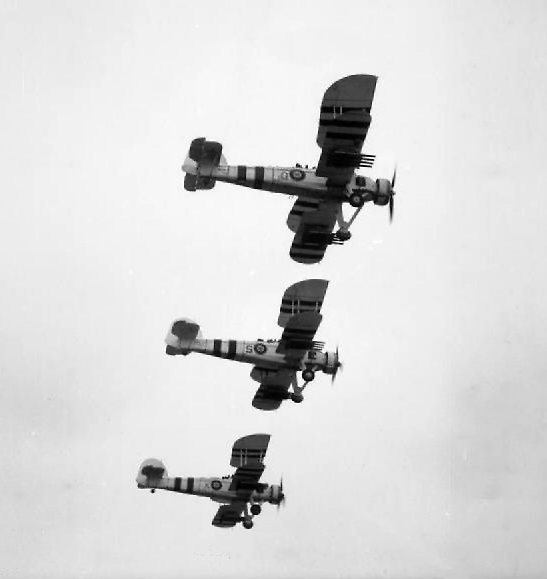
On 7 November her Squadron claimed a Ju 88 damaged and she operated moslty during the four hours daily light in low visibility or full darkness, with German aircraft heard in the vicinity. Her fulmar took off at 17:30 but electrics failed and she turned back, crashed landed into the safety barrier, being written off. On 10 November a Swordfish reported 30 Ju 88s approaching. All Wildcats from the three carriers took off and the remainder of the four Ju 88s down, two probable one baldy damaged were finished off by AA. They failed to hit any ship. Two Wildcats were also lost in AA confusion by fiendly fire. In the end, the carriers combined only six Wildcats. At 11:30 another Ju 88 attack was detected, Nairana’s Wildcats claiming one, the other downed by AA.
Return convoy RA 64 from Kola Inlet on 17 February was more risky, with one escort, one merchant ship torpedoed by U-Boats layin gin ambush. Another merchant was torpedoed later the afternoon. No flights due to weather conditions until 20 February. The Luftwaffe theh attacked, met by few Wildcats, still two Ju 88s were shot down, two by AA, three damaged. But the combined three carriers lost two more fighters. Nairana also escorted convoy JW 65 by March 1945 (2 merchants torpedoed), last losses of the Arctic convoys in WW2.
Postwar, Nairana was transferred to the Royal Netherlands Navy, in 1946 as HNLMS Karel Doorman. She embarked Hawker Sea Fury fighters and sailed in the far east to fight communist insurgents in Dutch East Indies in 1947, and when back home, was converted in 1948 back as merchantman “Port Victor”. Until March 1968 she worked for the Cunard Line and Blue Star Port Lines, Port Line in 1971, soled on 21 July to Faslane, BU.
 HMS Campania
HMS Campania
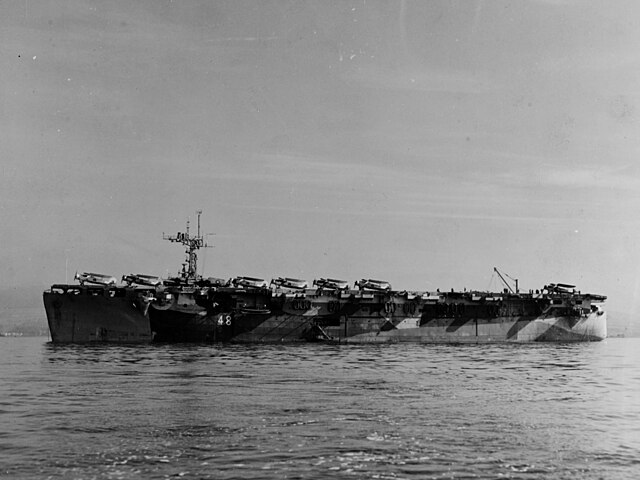
HMS Campania escorted convoys with ASW anti-submarine work in the Atlantic and Arctic like her sisters after being commissioned in February 1944, and obtaining the new Action Information Organisation (AIO) plus new Type 277 Radars capable of detecting low-level aircraft. 813 NAS aboard (12 Swordfish Mk III, 4 Wildcats, 3 Fulmars). First convoy with HMS Striker uneventful (JW 60, Arctic) but return RA 60 saw two merchants torpedoed and U-921 claimed. She lost with Stroker 5 Swordfish, 2 Wildcats. 1 November 1944 was Operation Golden, convoys JW and RA 61A for two passenger liners repatriating 11,000 Russians POWs and leaviung Russia on 10 November with Russian sailors for RN ships loaned. Her AG claimed two Blohm and Voss 138s (Wildcats 813 NAS, 1 lost accident).
Late November, Campania and Nairana had aboard 813 and 835 NAS (Swordfish III, Wildcat VI) to escort convoy JW and RA 62 threaten by joint U-boat and torpedo bomber attacks, no losses, claimed U-365 and two Ju 88s, one BV 138 for 2 Swordfish, 1 Wildcat lost.
6 February 1945 saw Campania, Nairana, cruiser HMS Bellona, eight destroyers in convoy JW64. same story as above. Campania had like Nairana a single Fairey Fulmar with AI interception radar. Campania’s Wildcats claimed later a Ju 88, lost one. Next morning firced Ju 88 atacks. Later Campania’s Swordfish flew only daylight ASW patrols with RP-3 rockets, two depth charges. 7 November one Ju 88 was claimed damaged in the four hours of daylight, heavy seas, low visibility. 10 November now massive attack, one Wildcat lost on Campania. Return convoy RA 64 had three ships losses but terrible weather conditions prevented the Luftwaffe to attack. She escorted JW 65 in March 1945, last arctic vonvoy with losses.
After the war ened she was briefly used as aircraft transport, then decommissioned, reserve in December 1945.
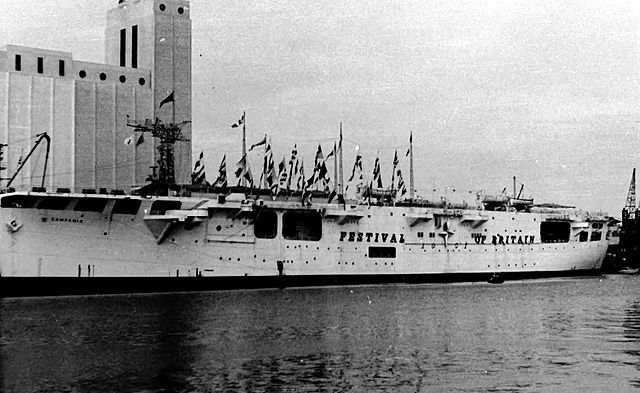
Campania dressed for “Festival of Britain” as completed. She was heavily flagged when in transit between ports, see.
She would have an unexpected role postwar with the “Festival of Britain”.
In 1951, she was displayed at the main Festival of Britain’s exhibition ship, touring the country’s ports with a civilian crew with many exhibitions inside and painted white under James Holland, which converted her as showboat with interiors remade by Pauline Baines and painted white (disarmed, no radar left). She was was decorated with skeleton masts and bunting, hangar divided into the “Land of Britain”, “Discovery” and “The People at Home” sections, and touring Britain from 4 May to 6 October (Southampton, Dundee, Newcastle, Hull, Plymouth, Bristol, Cardiff, Belfast, Birkenhead, Glasgow, staying 10–14 days each).
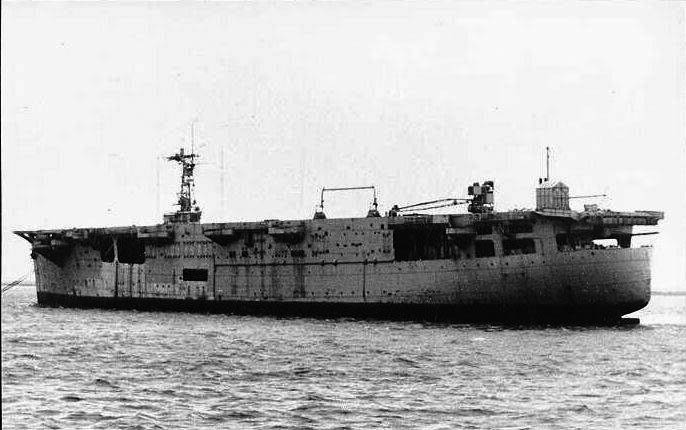
HMS Campania in Operation Hurricane, most modifications were internal. src destinationsjourney.uk
However after this, the Navy claimed her back and she was converted as atomic test ship for : Refitted in Birkenhead she became a command ship for the first British atomic bomb test one Monte Bello Islands, off western Australia. T=In the hangar were installed workshops, laboratories, offices and cabins and desalination plant, plus 1500 personnel including 85 scientists of the brtish atomic program. The fleet also comprised the landing ships Narvik, Zeebrugge, Tracker and frigate HMS Plym. Tracker had decontamination facilities. The bomb was detonated aboard Plym, the operation was under command of Rear Admiral Arthur David Torlesse. On Campania’s deck she had also three Westland Dragonfly helicopters, two Sea Otter aircraft plus cargo when re-commissioned, departing on 2 June 1952. She arrived on 8 August via Gibraltar, Cape Town, Mauritius, Fremantle and spent two months until the 3 October test. Not ideal as base shipn most scientists and engineers moved to ashore under tents. She was cramped and experienced scotching heat inside. She decommissioned again by December 1952 back home, sold and scrapped in Blyth, 1955.

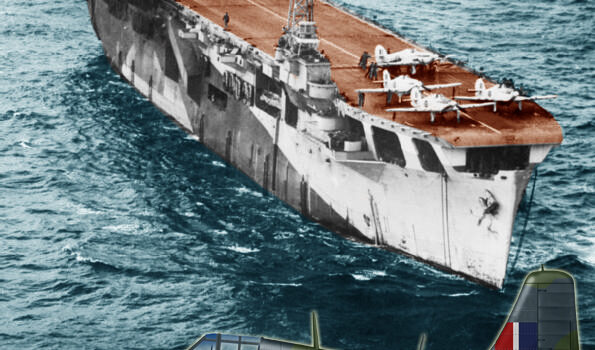
 Latest Facebook Entry -
Latest Facebook Entry -  X(Tweeter) Naval Encyclopedia's deck archive
X(Tweeter) Naval Encyclopedia's deck archive Instagram (@navalencyc)
Instagram (@navalencyc)





 French Navy
French Navy Royal Navy
Royal Navy Russian Navy
Russian Navy Armada Espanola
Armada Espanola Austrian Navy
Austrian Navy K.u.K. Kriegsmarine
K.u.K. Kriegsmarine Dansk Marine
Dansk Marine Nautiko Hellenon
Nautiko Hellenon Koninklije Marine 1870
Koninklije Marine 1870 Marinha do Brasil
Marinha do Brasil Osmanlı Donanması
Osmanlı Donanması Marina Do Peru
Marina Do Peru Marinha do Portugal
Marinha do Portugal Regia Marina 1870
Regia Marina 1870 Nihhon Kaigun 1870
Nihhon Kaigun 1870 Preußische Marine 1870
Preußische Marine 1870 Russkiy Flot 1870
Russkiy Flot 1870 Svenska marinen
Svenska marinen Søværnet
Søværnet Union Navy
Union Navy Confederate Navy
Confederate Navy Armada de Argentina
Armada de Argentina Imperial Chinese Navy
Imperial Chinese Navy Marinha do Portugal
Marinha do Portugal Mexico
Mexico Kaiserliche Marine
Kaiserliche Marine 1898 US Navy
1898 US Navy Sovietskiy Flot
Sovietskiy Flot Royal Canadian Navy
Royal Canadian Navy Royal Australian Navy
Royal Australian Navy RNZN Fleet
RNZN Fleet Chinese Navy 1937
Chinese Navy 1937 Kriegsmarine
Kriegsmarine Chilean Navy
Chilean Navy Danish Navy
Danish Navy Finnish Navy
Finnish Navy Hellenic Navy
Hellenic Navy Polish Navy
Polish Navy Romanian Navy
Romanian Navy Turkish Navy
Turkish Navy Royal Yugoslav Navy
Royal Yugoslav Navy Royal Thai Navy
Royal Thai Navy Minor Navies
Minor Navies Albania
Albania Austria
Austria Belgium
Belgium Columbia
Columbia Costa Rica
Costa Rica Cuba
Cuba Czechoslovakia
Czechoslovakia Dominican Republic
Dominican Republic Haiti
Haiti Hungary
Hungary Honduras
Honduras Estonia
Estonia Iceland
Iceland Eire
Eire Equador
Equador Iran
Iran Iraq
Iraq Latvia
Latvia Liberia
Liberia Lithuania
Lithuania Mandchukuo
Mandchukuo Morocco
Morocco Nicaragua
Nicaragua Persia
Persia San Salvador
San Salvador Sarawak
Sarawak Uruguay
Uruguay Venezuela
Venezuela Zanzibar
Zanzibar Warsaw Pact Navies
Warsaw Pact Navies Bulgaria
Bulgaria Hungary
Hungary

 Bundesmarine
Bundesmarine Dutch Navy
Dutch Navy Hellenic Navy
Hellenic Navy Marina Militare
Marina Militare Yugoslav Navy
Yugoslav Navy Chinese Navy
Chinese Navy Indian Navy
Indian Navy Indonesian Navy
Indonesian Navy JMSDF
JMSDF North Korean Navy
North Korean Navy Pakistani Navy
Pakistani Navy Philippines Navy
Philippines Navy ROKN
ROKN Rep. of Singapore Navy
Rep. of Singapore Navy Taiwanese Navy
Taiwanese Navy IDF Navy
IDF Navy Saudi Navy
Saudi Navy Royal New Zealand Navy
Royal New Zealand Navy Egyptian Navy
Egyptian Navy South African Navy
South African Navy






























 Ukrainian Navy
Ukrainian Navy dbodesign
dbodesign
Late 1944 Nairana operated at full capacity with six Wildcats and fourteen Swordfish, so 18 aircraft. Vindex in 1945 reversed the trend with two Wildcat squadrons (12) and one of Swordfish (8);
6 + 14 is not equal to 18.
Fixed, thx for spotting !